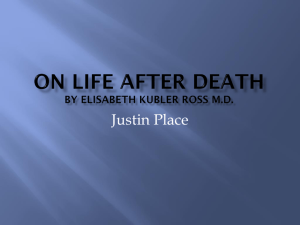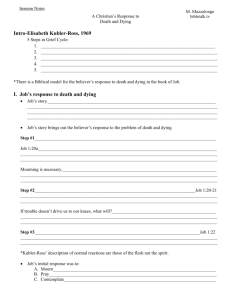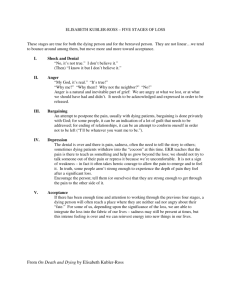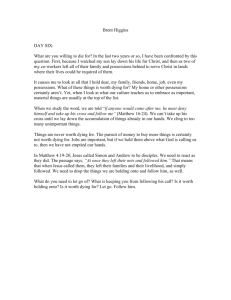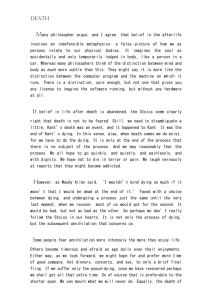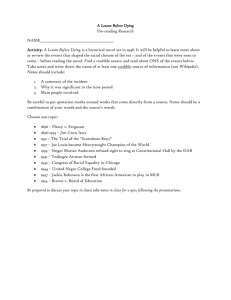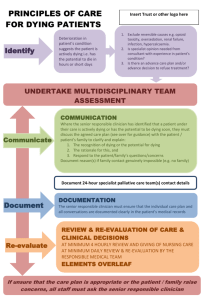Dying and the Near-Death Experience - U
advertisement
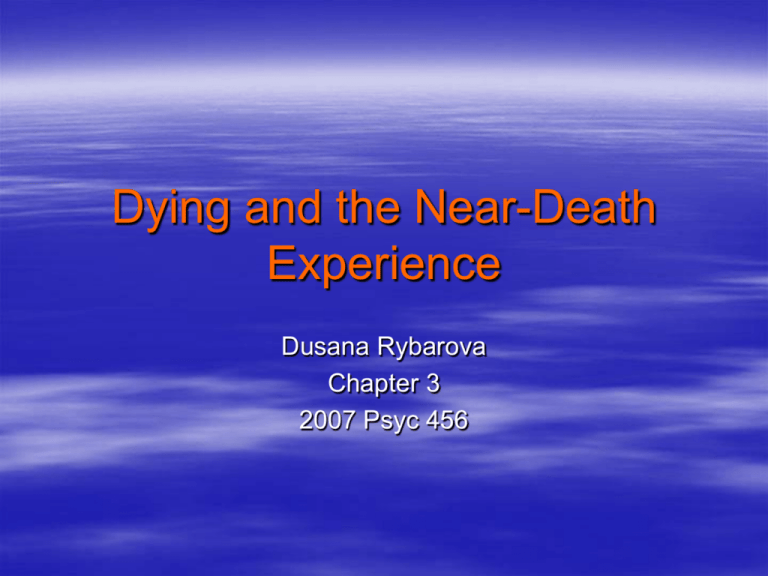
Dying and the Near-Death Experience Dusana Rybarova Chapter 3 2007 Psyc 456 PTSD revisited Most clinicians agree that victims of PTSD should face the original trauma to be able to cope with the debilitating effects of the disorder Exposure Therapy Helps PTSD Victims Overcome Trauma's Debilitating Effects – In the 1980’s, Dr. Terence M. Keane and his colleagues found that exposure therapy was effective in treating the PTSD symptoms of Vietnam War veterans. Exposure therapy, previously known as imaginal flooding therapy, involves carefully exposing the patient to prolonged and repeated imagined images of the trauma until the images no longer cause severe anxiety. In Keane’s randomized clinical trial involving 24 Vietnam veterans, Keane found that exposure therapy was effective in reducing many of the veteran’s PTSD symptoms, including nightmares, flashbacks, memory and concentration problems, and irritability. http://www.psychologymatters.org/keane.html For more on efficacy of psychological treatments for PTSD check – http://www.nimh.nih.gov/publicat/reliving.cfm – http://www.ncptsd.va.gov/ncmain/ncdocs/fact_shts/fs_treatmentforptsd.html Kubler-Ross’ Stage Model of Dying Pioneered research with the dying in 1960s – Difficulty in access to dying patients hindered by physicians – Patients were usually surprised, amazed, and grateful; relieved to share their last concerns and expressing their feelings – Interviewed 400 dying persons over a 10 year period Her work resulted in a book – On Death and Dying (1969) usual stages of dying Stages of dying according to Kubler-Ross Shock/Denial – Numbness, shock, withdrawal and cognitive denial – Can take from few seconds to few months – 1% of terminally ill people stay in that stage Anger – Envy and resentment of those whose lives will continue – Anger can be expressed towards everyone they encounter in various forms such as complaints – Important to see the dying person as a unique human being engaged in the process of grieving rather than somebody who is threatening or just a ‘patient’ Stages of dying according to Kubler-Ross Bargaining – Making promises (usually towards spiritual figures) in exchange to more time to live – It is natural and healthy way to cope with the reality of approaching death Depression – Acute depression, the dying regrets past failures and mistakes that can not be corrected – Grief about the lost time – Recognition of approaching death Stages of dying according to Kubler-Ross Acceptance – Without anger or depression – ‘it’s my time now, and it’s all right’ without defeat or disappointment – In our culture the dying person is often drowsy, withdrawn, drugged, and asleep much of the time – Often does not like to engage in conversation – But, it is important to show that others care through physical presence – The dying often realizes our connectedness to all living/dying beings Stages of dying according to KublerRoss – Advantages and Criticism Positive aspects – Focus on humane treatment of the dying and their needs – Encourages the caregivers to view the world through the eyes of the dying – Learning from the dying about ourselves, our values and our own search for values Critique – Lack of empirical support in scientific literature – Restrictive nature of the stages – Problem with the way it was applied by healthcare professionals – annoyance if the dying people do not move neatly through the expected stages Pattison’s Phase Model Based on his book The Experience of Dying (1977) Lists three phases of dying to assist clinical practice – not meant to be viewed as inevitable – The acute phase – The chronic living/dying phase – Terminal phase Pattison’s Phase Model The Acute Phase – Corresponds to Kubler-Ross’ denial, anger, and bargaining stages – Rising anxiety can result in frozen fear – the person can not function – For caregivers Emphasizing reality issues connected to dying Providing emotional support throughout the process Pattison’s Phase Model The Chronic Living/Dying Phase – Confrontation of fears surrounding dying and death 1. Fear of abandonment - ranked as number one fear of the dying - dying without loved ones - may include fear of loneliness, fear of social death, fear of loss of family and friends 2. Fear of loss of self control - sense of dependency on others - feeling ugly and unacceptable - important to keep sense of power and authority over day-to-day lives Pattison’s Phase Model 3. Fear of suffering and pain - 50% of dying patients in American hospitals report moderate to sever pain during their final days - helps to reframe attitudes to view the pain as part of the disease process not punishment or abandonment 4. Fear of loss of personal identity - loss of loved ones, body functions, consciousness, and control over life as a threat to the self - important to keep in touch and maintain contact with work and community whenever possible Pattison’s Phase Model 5. Fear of the Unknown - questions about afterlife – spiritual crisis in some cases - what will happen to his/her family 6. Fear regression into Self - facing the experience of entering ‘… into a primordial sense of being where there is no awareness of time or space or boundaries between self and others..’ (Pattison, 1977:55) -dying person may fight against the regression resulting in so-called death-agonies Pattison’s Phase Model Terminal phase – Realizing that death is not going to go away – Social death Physical separation from loved ones and community – Psychological death Regress deep into self by way of various states of consciousness (sleep, dream, coma) – Biological death Vegetative stage – no intentional (purposeful) activity – Physiological death Vital organs stop operating Humanistic psychologists such as Maslow were first to acknowledge higher needs - need for love, selffulfillment, aesthetic and spiritual needs http://chiron.valdosta.edu/whuitt/col/regsys/maslow.html Corr’s Task-based Coping Model Charles Corr (1992) – coping model of active participation in living our dying – Physical needs Communicating needs such as pain control, nutrition, hydration, sleep pattern to family and medical staff – Psychological needs Needs of psychological security, autonomy, richness As identified by caregivers healthy death was associated with approaching death with seriousness as well as humor, reviewing past, exploring afterlife, discussing practicalities of dying with others etc. Corr’s Task-based Coping Model – Social needs Sustaining and enhancing relationships that we value Finishing unfinished business Deciding who to spend the terminal phase of life with – Spiritual needs Seeking source of spiritual nurturance and meaning Three principal spiritual tasks for the dying – The need to find meaning in or the ultimate significance of life – The need to die an appropriate death (appropriate with respect to our values, and spiritual beliefs) – The need to transcend death (reassurance of immortality or continuity of future generations) Final moments Sleep/Death analogies Regression into self (Pattison, 1977) – The state of consciousness we experience just before we fall to sleep each night, or just before we are awake Hypnagogic state of consciousness – altered state of consciousness between wakefulness and sleep Greeks talk about similarities between death (thanatos) and sleep (hypnos) Sogyal Rinpoche (1992:344) ‘The senses and grosser layers of consciousness dissolve… Next, there is a dimension of consciousness which is so subtle we are normally completely unaware of its very existence…’ Near-death Experiences Near-death experience (NDEs) – Individuals at the edge of permanent death are revived Raymond Moody (1975) pioneered work on NDE Survivors describe death as unpleasant at first, but upon ‘letting go’ they report experiences of great joy – Travel through darkness, then trough a tunnel filled with bright light; – afterwards the mind emerges into the bright light, often accompanied by beings of light; – reports of ‘life reviews’ Research shows that NDEs occur in other cultures as well http://www.nderf.org/ Dimensions of the Near-Death Experience Hyperalertness dimension – Higher levels of attention – Thoughts and images become sharper and speeded up – Visions become highly intense Depersonalization dimension – Experience of lacking personal identity – Sense of detachment – Loss of ability to keep track of time Dimensions of the Near-Death Experience Out-of-body dimension – Awareness of what is happening to the body with accompanying feeling of being separate from it – Floating above the body while others are trying to revive it – Viewing body as watching a movie, detachment – NDE survivors reporting information they could not have found out about through guesswork or prior knowledge Mystical dimension – Transcendence, leaving earthly dimension – Encounters with mystical beings or invisible spirits – Harmony, revelation, unity, joy The Death-as-Door Thesis The spiritual view Awakening of latent spiritual energy such as holy spirit, vital winds, chi, tumo or kundalini which can lead to the experience of enlightenment or illumination Across spiritual traditions – Death leading to resurrection and everlasting life – Hindi – reincarnation – Tibetan Buddhist – door into bardo (state in between, in this case between death and future rebirth) The Death-as-Wall Thesis The scientific view NDE as strong reactions of the nervoussystem enabling us to adapt to dangerous circumstances – Not everyone experiences NDEs or ‘dies’ blissful, accepting death – The NDE can occur in situations not related to death – We hear reports of NDE only from the survivors The near-death event as a major life transition Impact of NDE on the survivors: – Reduction in death anxiety – Focus on here and now rather than preoccupation with death – Sense of relative invulnerability – Strong belief in continued existence – Significant shift towards spirituality – Changes in values, priorities towards love and caring of others – New interests in caring aspects of human relationships
